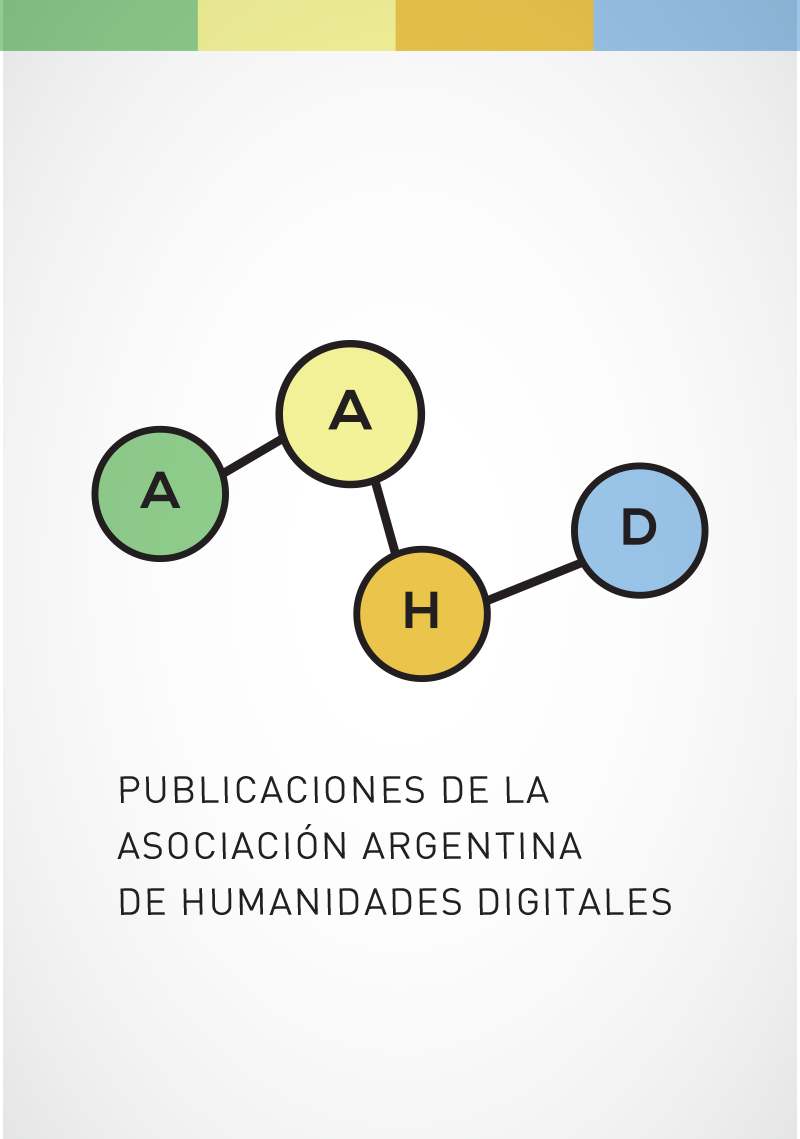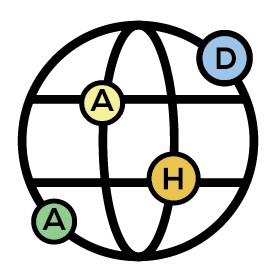Social Network Analysis in the History of Sciences
Visualising Sociability in Scientific Expeditions with Gephi
DOI:
https://doi.org/10.24215/27187470e019Keywords:
Social Network Analysis, Network Visualization, Gephi, Louis Agassiz, Henry Walter BatesAbstract
With its origins in Sociology, social network analysis has gained popularity with the development of both Digital Humanities and free network visualization software, such as Gephi. For the History of Sciences, network analysis can highlight how scientific knowledge is socially constructed and dependant on the interactions between individuals and institutions. In this paper I demonstrate how the analysis and visualization of networks with Gephi can be a valuable tool to understand the sociability of 19th century scientific expeditions by investigating Louis Agassiz’s and Henry Walter Bates’ travels in Brazil.
Downloads
References
Agassiz, L., and Agassiz, E. C. (1868). A Journey in Brazil. Ticknor and Fields. https://archive.org/details/journeyinbrazil00agasiala
Antunes, C. (2012). A história da análise de redes e a análise de redes em história. História, Revista da Faculdade de Letras da Universidade do Porto, 2(IV), 11-22. http://ler.letras.up.pt/uploads/ficheiros/11313.pdf
Antunes, A. P. (2015). A rede dos invisíveis: uma análise dos auxiliaries na expedição de Louis Agassiz ao Brasil (1865-1866). (Dissertação do Mestrado em História das Ciências e da Saúde). Casa de Oswaldo Cruz, Fundação Oswaldo Cruz.
Antunes, A. P. (2019). Um naturalista e seus colaboradores na Amazônia: a expedição de Henry Walter Bates ao Brasil (1848-1859). (Tese do Doutorado em História das Ciências e da Saúde). Casa de Oswaldo Cruz, Fundação Oswaldo Cruz.
Bates, H. W. (1863). The naturalist on the River Amazons. A record of adventures, habits of animals, sketches of Brazilian and Indian life, and aspects of nature under the Equator, during eleven years of travel (vol. I). John Murray. https://archive.org/details/naturalistonrive01bate
Bradford, W. C. (2004). Reaching the Visual Learner: Teaching Property through Art. The Law Teacher, 11. https://papers.ssrn.com/sol3/papers.cfm?abstract_id=587201
Camerini, J. (1997). Remains of the day: early Victorians in the field. In B. Lightman (Ed.), Victorian science in context (pp. 354-377). The University of Chicago Press.
Center for History and Economics. Harvard University. (2017). Method. Visualizing Historical Networks. http://histecon.fas.harvard.edu/visualizing/index.html#4
Chen, L. (Ed.). (2020). A journey of discovering Sociology: what Sociology is in 20 contemporary American sociologists’ eyes. Peking University Press.
Farley, J., and Geison, G. L. (1994). Ciencia, política y generación espontánea en la Francia del siglo diecinueve: el debate Pasteur-Pouchet. In C. Solís, Razones e intereses. La historia de la ciencia después de Kuhn (pp. 219-263). Paidós.
Fleck, L. (2010 [1935]). Gênese e Desenvolvimento de um Fato Científico: Introdução à doutrina do estilo de pensamento e do coletivo de pensamento. Fabrefactum Editora.
Ginzburg, C. (1989). Mitos, emblemas, sinais: morfologia e história. Companhia das Letras.
Gold, M. K. (Ed.). (2012). Debates in the Digital Humanities. University of Minnesota Press.
Heymann, S. (2010). Gephi initiator interview: how “semiotics matter”. Gephi blog. https://gephi.wordpress.com/2010/02/01/gephi-initiator-interview-how-semiotics-matter/
Jacomy, M., Bastian, M., and Heymann, S. (2009). Gephi: An Open-source Software for Exploring and Manipulating Networks. In Association for the Advancement of Artificial Intelligence, Proceedings of the Third International AAAI Conference on Weblogs and Social Media. https://www.aaai.org/ocs/index.php/ICWSM/09/paper/view/154
Jacomy, M., Venturini, T., Heymann, S., and Bastian, M. (2014). ForceAtlas2, a Continuous Graph Layout Algorithm for Handy Network Visualization Designed for the Gephi Software. PLoS ONE, 9(6), e98679. https://doi.org/10.1371/journal.pone.0098679
Kuhn, T. (1998 [1962]). A estrutura das revoluções científicas. Editora Perspectiva.
Luke, D. A., and Harris, J. K. (2007). Network Analysis in Public Health: History, Methods, and Applications. The Annual Review of Public Health, (28), 69-93. https://www.annualreviews.org/doi/pdf/10.1146/annurev.publhealth.28.021406.144132
Ma, K-L., Liao, I., Frazier, J., Hauser, H., and Kostis, H-N. (2012). Scientific Storytelling Using Visualization. IEEE Transactions on Visualization and Computer Graphics, 32(1), 12-19. https://ieeexplore.ieee.org/document/6111347
Mathias, C. L. K. (2014). Análise de rede social. Revista Internacional Interdisciplinar INTERthesis, 11(1), 131-146. http://dx.doi.org/10.5007/1807-1384.2014v11n1p131
Moreira, I. de C. (2002). O escravo do naturalista. Ciência hoje, 31(184), 41-48. http://www.casadaciencia.ufrj.br/caminhosdedarwin/downloads/escravo.pdf
Moreno, J. L. (1934). Who shall survive? A new approach to the problem of Human interrelations. Nervous and Mental Disease Publishing Co.
Otte, E., and Rousseau, R. (2002). Social network analysis: a powerful strategy, also for the information sciences. Journal of Information Science, 28(6), 441-453. https://journals.sagepub.com/doi/abs/10.1177/016555150202800601
Padgett, J. F., and Ansell, C. K. (1993). Robust Action and the Rise of the Medici, 1400-1434. American Journal of Sociology, 98(6), 1259-1319. https://www.jstor.org/stable/2781822
Pandolfi, F. C., and Bueno, N. P. (2014). Análise de redes sociais em História: noções básicas e sugestões de aplicação. In Anais do XIX Encontro Regional de História. Juiz de Fora, 28 a 31 de julho de 2014 (pp. 1-11). http://www.snh2011.anpuh.org/resources/anais/34/1401385226_ARQUIVO_anpuhpaper29-05corrigido.pdf
Pratt, M. L. (1999). A crítica na zona de contato: nação e comunidade fora de foco. Travessia, (38), 7-29. https://periodicos.ufsc.br/index.php/travessia/article/download/14665/13434
Raj, K. (2009). Mapping knowledge go-betweens in Calcutta, 1770-1820. In S. Schaffer, L. Roberts, K. Raj, and J. Delbourgo (Eds.), The brokered world. Go-Betweens and Global Intelligence, 1770-1820 (pp. 105-150). Science History Publications.
Stanford University. (2013). Mapping the Republic of Letters. http://republicofletters.stanford.edu/
Subrahmanyam, S. (1996). Merchant Networks in the Early Modern World, 1450-1800. Variorum.
Vermelho, S. C., Velho, A. P. M., and Bertoncello, V. (2015). Sobre o conceito de redes e seus pesquisadores. Educação e Pesquisa, 41(4), 863-881. http://dx.doi.org/10.1590/s1517-97022015041612
Zacks, J., Levy, E., Tversky, B., and Schiano, D. (2002). Graphs in Print. In M. Anderson, B. Meyer, and P. Olivier (Eds.), Diagrammatic Representation and Reasoning (pp. 187-206). Springer. https://doi.org/10.1007/978-1-4471-0109-3_11
Downloads
Published
How to Cite
Issue
Section
License
Copyright (c) 2021 Anderson Pereira Antunes

This work is licensed under a Creative Commons Attribution-NonCommercial 4.0 International License.
Los autores que publican en esta revista están de acuerdo con los siguientes términos:
- Los artículos publicados en la revista se encuentran disponibles en acceso abierto.
- Los autores conservan los derechos de autor y garantizan a la revista el derecho de ser la primera publicación del trabajo al igual que licenciarlo bajo una Licencia Creative Commons Atribución-CompartirIgual 4.0 Internacional (CC BY-SA 4.0), que permite copiar y redistribuir el material en cualquier medio o formato y remezclar, transformar y construir a partir del material bajo los siguientes términos: debe dar crédito de manera adecuada, brindar un enlace a la licencia, e indicar si se han realizado cambios.
- Los autores pueden depositar el trabajo en un repositorio de preprints, postprints, establecer por separado acuerdos adicionales para la distribución no exclusiva de la versión de la obra publicada en la revista (por ejemplo, situarlo en un repositorio institucional o publicarlo en un libro), con un reconocimiento de su publicación inicial en esta revista.
- Se alienta a los/as autores/as a realizar el depósito de datos en SEDICI, o en cualquier otro repositorio de datos de investigación (como Zenodo, donde la AAHD ha creado un repositorio temático para HUMANIDADES DIGITALES), de manera previa a realizar el envío de la contribución a la revista. De este modo, al remitir el artículo solo se deberá indicar la URL donde se encuentran los datos de investigación.


























